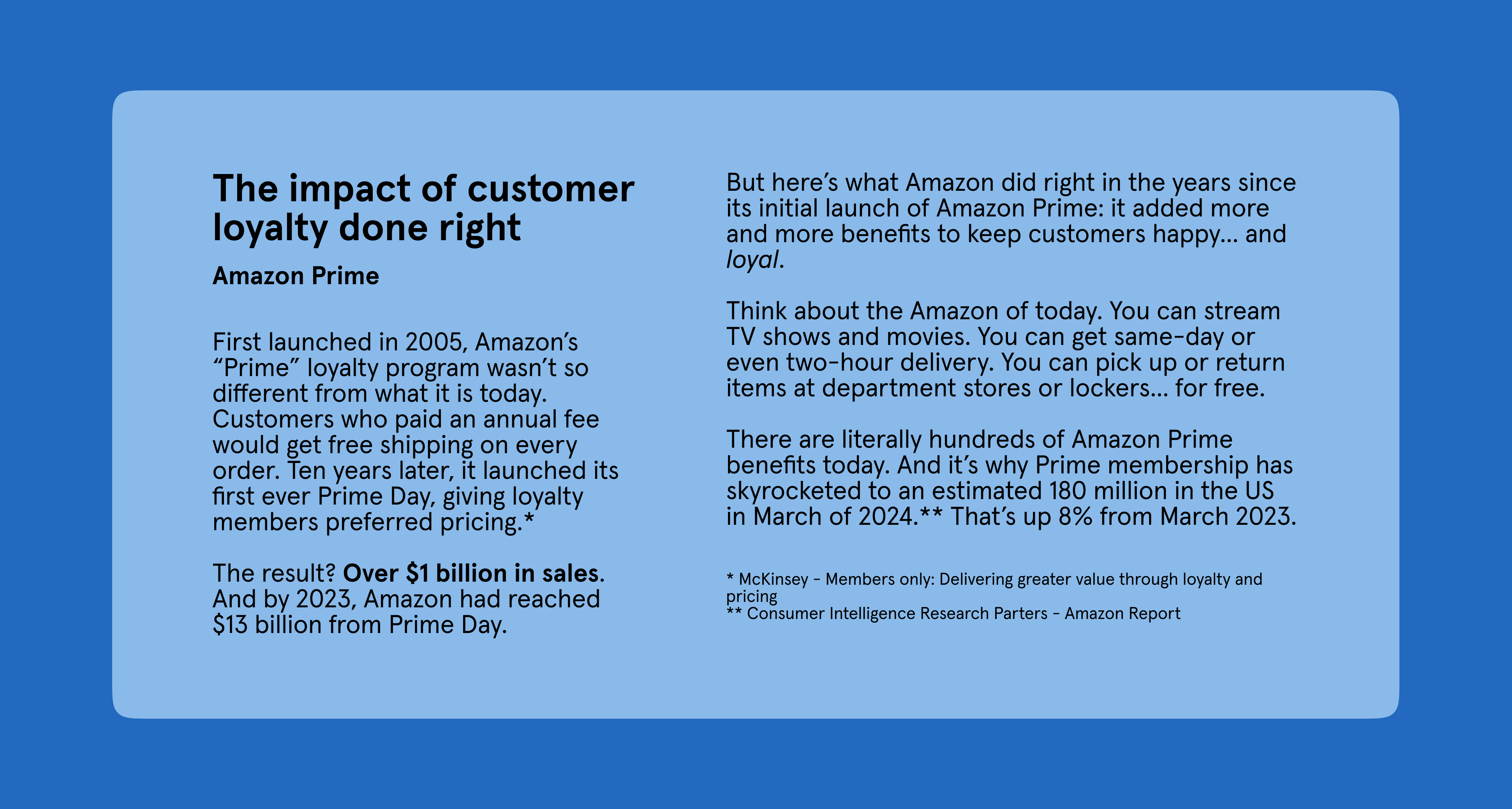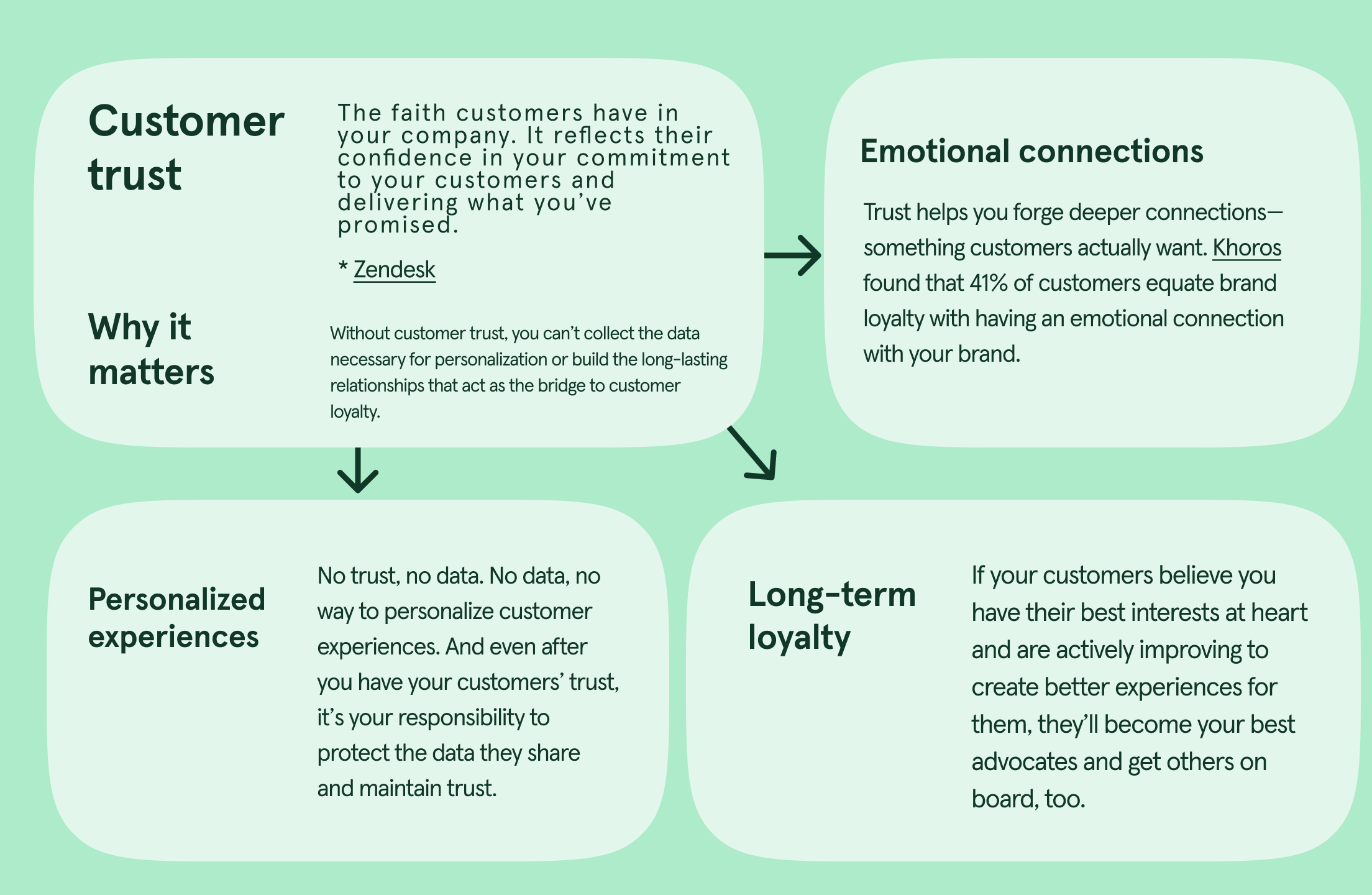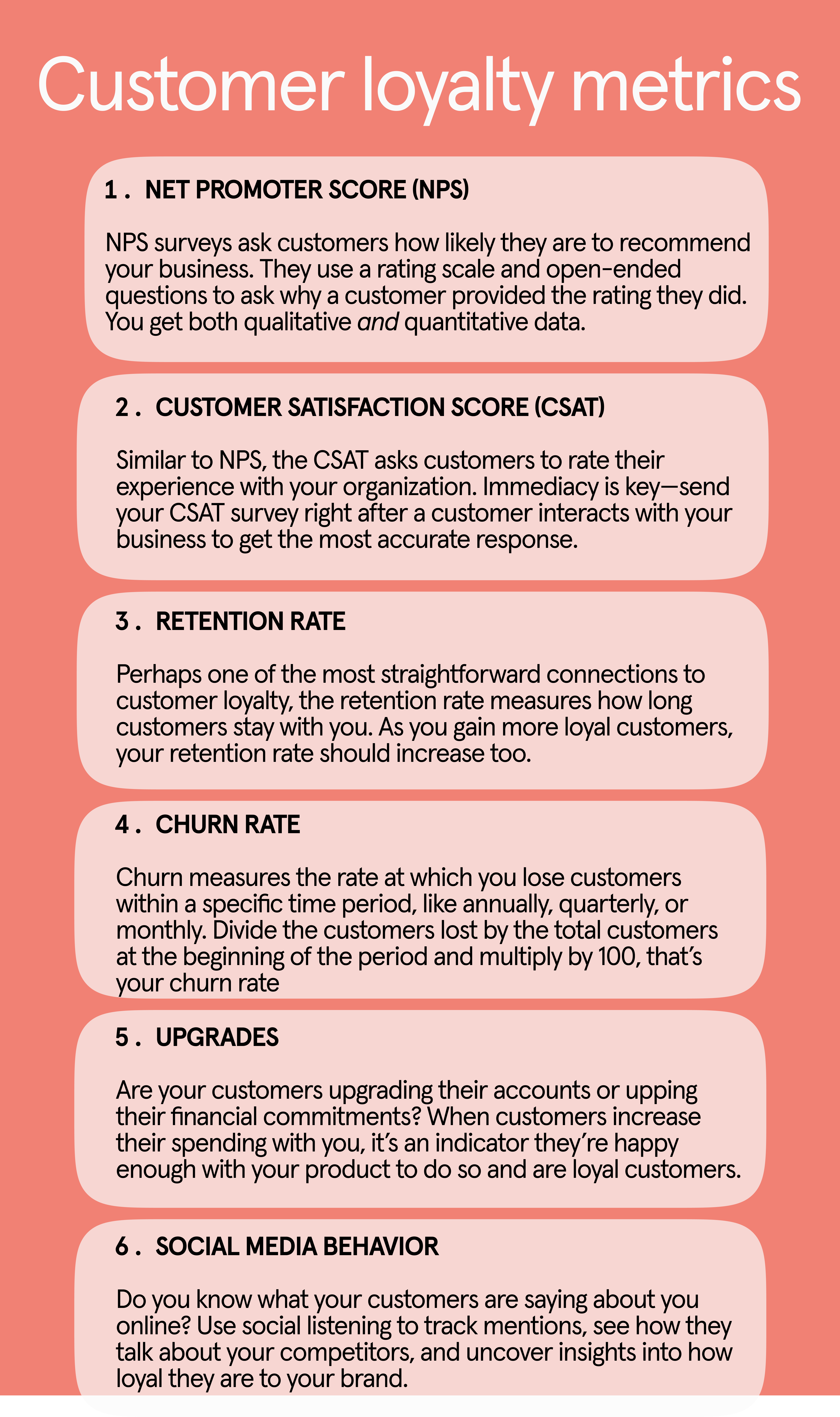Our view at Stack - Typeform is our go-to software if we need to ask a set of structured questions of a group of customers, prospects or leads. In summary, Typeform combines aesthetics, functionality, and flexibility. User-friendly form builder with interactive design, versatile question types, real-time data collection, 500+ integrations, and diverse templates. Ideal for engaging surveys and lead generation.
Apple. Nike. Starbucks. What do they all have in common? A loyal customer base. I should know—I would never use any laptop other than a Macbook, be caught dead in Adidas, or get my coffee from anywhere else. Why? Customer loyalty.
Sure, there are cheaper options out there. But that’s my point: customer loyalty isn’t about transactions—it’s about a strong emotional connection with your brand.
What is customer loyalty?
The most basic definition of customer loyalty is when customers come back to your business over and over. But most people go to the same grocery store every week—not out of loyalty, but out of convenience. That’s not what we’re talking about.
While repeat business is indeed part of customer loyalty, the more important aspect is the why. Zendesk sums it up:
“Loyal buyers consistently choose to do business with a particular brand and often defend it against its competitors. [It] entails developing a customer base so devoted to your brand that they’re willing to buy whatever you offer—no matter the price—even when there are cheaper alternatives in the market.”
Getting customers to be loyal to you, and only you, starts with personalization and creating an extraordinary customer experience (CX) that inspires buyers to come back again… and again.

Transactional vs. emotional loyalty
Not all customer loyalty is equal. Let’s take my loyalty to Starbucks. Despite a dozen coffee shops within walking distance and cheaper options, I remain loyal to Starbucks. But the grocery store I go to? Whatever’s cheapest.
Every barista knows my name and order, and they always have a pup cup ready for my dog. They’ve built a strong emotional connection with me, creating emotional loyalty. This form of loyalty is where consumers are 100% devoted to your brand, regardless of:
-
Convenience
-
Price
-
Other factors
Transactional loyalty is the opposite. Customers choose you because of the perceived value you provide, but if they moved, lost their jobs, or circumstances changed, they’d drop you.
Let’s say they get their groceries from Kroger but move closer to an Aldi. They’ll switch to Aldi simply because it’s more conveniently located.
While you want to aim for emotional loyalty, keep in mind that most devoted customers start as transactionally loyal customers. Building an emotional connection takes time—don’t write off your transactionally loyal customers just yet.
Trust and commitment—the foundations of customer loyalty
More than 80% of customers won’t buy from brands they don’t trust. And if you break that trust… 89% will leave you.
Trust and credibility are foundational in building your army of loyal fans. But it’s not always easy to earn customer trust—you need to create an emotional connection by being transparent, sensitive, and dependable.

-
Affective. Commitment based on positive emotions customers connect to your brand. It inspires customers to remain loyal and establishes trust. These customers are emotionally invested and often become brand advocates.
-
Continuance. Commitment based on logic and staying with a brand because it’s convenient or cheaper. It’s less about emotions and more situational—like the grocery store example.
-
Normative. Commitment based on obligation. These customers have no emotional connection with your brand and solely stick with you because they have to—like an electric company.
If you can cultivate effective commitment and move customers closer to “brand advocate” status, you’ll reap another revenue-generating benefit: customer retention.
Customer loyalty ↔ customer retention
Both customer loyalty and retention can grow your revenue, but they aren’t the same.
Customer retention takes a set period and measures how many customers continue buying from you—the more that keep buying your services in that timeframe, the higher the retention rate. It’s obviously good for business, but it can also reduce acquisition costs:
-
Acquiring new customers can be 5-7 times greater than the cost of retaining customers
-
If you increase retention rates by 5%, you can boost profits by anywhere from 25 to 95%
On the other hand, customer loyalty paints a bigger picture of the relationship between you and your customers. HubSpot explains that “loyal customers don’t just come back—they often spend more money. They don’t simply buy your products—they offer referrals and testimonials and speak highly of your company.”
Not only do they spend more, but they do word-of-mouth marketing for you.
“Customer retention speaks to reliable revenue. Customer loyalty creates opportunities for growth”
How they’re connected
Customer loyalty helps with retention, while deliberate retention strategies boost customer loyalty. Here’s how:
-
Loyal customers increase revenue with repeat purchases and potentially bring in more customers as they rave about your product or service.
-
They reduce customer acquisition costs—all you have to do is keep them happy and they’ll stay.
-
Loyal customers provide insightful feedback that ensures they continue doing business with you and helps you improve so you can retain other customers.
As you increase customer loyalty, customer retention improves.
Customer loyalty starts with psychology
We all strive for happy, loyal customers. But how do you actually build an emotional connection and enough trust to foster loyalty? Psychology.
Let’s explore some psychological drivers of customer loyalty and how to leverage them to turn customers into loyal fans.
1. Emotional connections
“Emotional connection” might sound like a fluffy marketing term, but the facts don’t lie: loyal customers are those who connect with your brand.
Or Nike and its famous “Just do it” slogan that inspires athletes of all kinds to achieve their fitness goals.
And Disney—a master of emotion, evoking nostalgia in adults and magic in children.
They’ve all built brands around emotion and connecting with customers. The move from transactional to emotional relationships builds long-lasting bonds that drive customer loyalty. Here’s how they do it:
-
Exceptional storytelling that sparks emotions, like joy or nostalgia
-
Emotional branding that does more than sell a product
2. Perceived value
The perceived value of your product is what your customers think it’s worth. Some people might think a $2,500 Macbook Pro is outrageous. For others, the perceived value is so high that they’ll happily pay a hefty price to get that laptop.
Perceived value is more than simply what you get for the money though. Let’s break it down with designer denim. A $50 pair of jeans likely gets the job done—the zipper works, they’re durable, and you can wear them almost anywhere.
And then you’ve got the $175 pair of jeans that so many are willing to pay for. Why? Because they’re less focused on functionality and more on how the jeans make them feel. Well-fitting designer denim might make customers feel confident, classy, or stylish with elevated designs.
-
Functional: customers want a product that works well and offers practical features that make their lives easier.
-
Monetary: these customers are all about price and getting a good deal—they’ll look for affordable options.
-
Psychological: customers care about how your product makes them feel, like happy or confident, and it’s driven by emotional connection.
-
Social: customers want products that align with their social identity—they’ll buy products that show that they’re part of a certain group.
Each contributes to what customers are willing to pay for your product. You need to build enough perceived value to get customers to keep buying your products and become loyal advocates.
3. Customer satisfaction
Customer satisfaction reflects how happy customers are with your product and can be an indicator of customer loyalty. But just because customers are satisfied doesn’t mean they’ll be loyal.
Remember, we might be happy with the food we get from the grocery store, but if one with cheaper prices pops up, we’d leave.
Likewise, dissatisfied customers share their negative experiences with your brand on social media, you lose their business, and they may influence others not to buy from you.
Customers have millions of choices—if customer satisfaction is low, they’ll leave. But gathering feedback and implementing it can help boost customer satisfaction and trust, which are vital parts of customer loyalty.
4. Community and social influences
Thanks mostly to Gen Z (and Millenials to a degree) #TikTokMadeMeBuyIt has boosted sales for small and big brands alike and displayed the power of social influence on purchase decisions.
Nearly 50% of TikTok users have admitted to buying a product after seeing someone review, promote, or advertise on the app. That’s community and social influence at its finest.
Just take a look at Little Moons. The company saw a 700% increase in sales after going viral on TikTok.
But what about after the hype dies down? Does social influence lead to customer loyalty? Sometimes.
Customers tend to trust brands that have a lot of positive reviews and endorsements from other customers or trusted influencers. Social influence builds trust organically and can create a sense of community among those who love your brand.
But influences from online or brand communities aren’t enough to ensure customer loyalty. You can leverage them to build trust and increase your perceived value, but it’s your job to maintain that trust and keep customers happy.
How to measure customer loyalty
Whether you’re measuring the success of a marketing campaign or a newly launched customer success initiative, you’re likely using key performance indicators (KPIs) and metrics. The same goes for customer loyalty.
Start by measuring the factors that impact customer loyalty, like customer satisfaction, repeat purchases, and retention rates.

Brands doing customer loyalty programs right
Amazon Prime offers members high-value benefits like free and priority shipping, while clothing brands like Fabletics reward customers with points to redeem for items later.
Every customer loyalty program looks different, but they all have one thing in common: they reward customers who remain loyal. Starbucks and The North Face both have exceptional loyalty programs. Let’s take a look!
Starbucks
Starbucks Rewards is a comprehensive loyalty program that rewards customers with everything from free drinks to miles on your Delta SkyMiles account. Here’s how it works:
-
You sign up for the program and download the Starbucks app
-
You earn stars every time you make a purchase
-
You redeem those stars for free drinks, bakery items, sandwich boxes, or merch
-
You can order ahead with the mobile app and skip the line
But here’s what makes it different—gamification. The Starbucks app hosts games and challenges that let users collect even more stars or enter giveaways. They can also access perks like double-star days, free birthday drinks, and more.
Starbucks’ loyalty program has enough added perks to boost its perceived value, but there’s also a community aspect. Starbucks is heavily involved in local and global communities, offering grants and partnerships with disaster recovery organizations like the Red Cross.
This further fosters a sense of community and an emotional connection.
Bonus: Starbucks prioritizes personalization by saving previous locations and orders, giving you a birthday treat, and greeting you by name in the app.
The North Face
The North Face’s XPLR Pass is a points-based loyalty program that lets members earn points outside of simply purchasing The North Face items, like:
-
Attending The North Face events
-
Referring friends
-
Bringing reusable bags when in-store shopping
-
Checking in to national parks on the app
-
Participating in member surveys
-
Checking in to The North Face stores on the app
Members earn one point per dollar spent, plus points for the above and a 10% new member discount. They can redeem them for products at The North Face.
But it’s The North Face’s trade-in program that sets the brand apart. Loyalty members can trade in lightly used The North Face gear for a gift card. And its members-only field testing encourages members to test their purchase and see how it performs in the wild. If it doesn’t meet expectations, they can return it.
Another benefit? Early and exclusive access to limited-edition gear and collaborations.
The North Face plays into nearly every tenet of customer loyalty:
-
Ensuring customer satisfaction with members-only field testing
-
Becoming part of a privileged community with early access to exclusive gear
-
Building trust and credibility by offering multiple non-monetary ways to earn points
-
Proactively seeking customer feedback to improve
Turning customers into fans, one psych lesson at a time
Long gone are the days of companies treating customers as transactions and dollar signs. Today’s savvy consumers patronize brands they trust—ones that prioritize forging genuine emotional connections with them.
And consumers have rewarded brands that get this right with continued loyalty. Brands like Nike, Apple, and Amazon have all figured out how to build emotional connections with their customers by:
You can too. So, dust off your psychology books and leverage the psychological triggers that drive loyalty.
If Typeform is of interest and you'd like more information, please do make contact or take a look in more detail here.
Credit: Original article published here.
